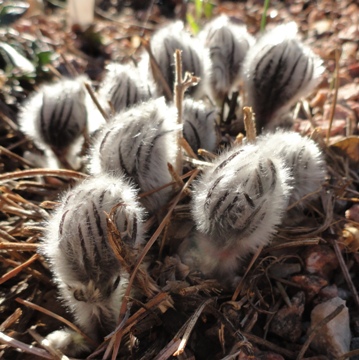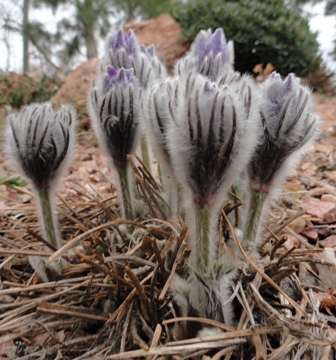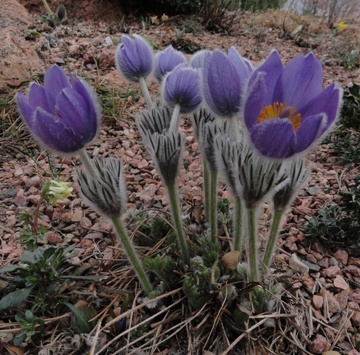Furry friends: the society of Pasqueflower devotees...
 In the Dakotas they call them "prairie crocus'. Elsewhere you usually hear them called pasqueflowers, although I think the ones this year at the Gardens will mostly be done blooming by Easter...these near relations to Anemone are irresistible to anyone who loves puppies, kittens and things that are cuddly, adorable and soft. One or another kind of pasqueflower is found on plains, tundra and mountain meadows across the northern hemisphere: dozens of names can be found in floras, and hundreds of variants in every color from yellow and vermilion through the spectrum of lavenders, purples and near blues and of course crystalline whites.
In the Dakotas they call them "prairie crocus'. Elsewhere you usually hear them called pasqueflowers, although I think the ones this year at the Gardens will mostly be done blooming by Easter...these near relations to Anemone are irresistible to anyone who loves puppies, kittens and things that are cuddly, adorable and soft. One or another kind of pasqueflower is found on plains, tundra and mountain meadows across the northern hemisphere: dozens of names can be found in floras, and hundreds of variants in every color from yellow and vermilion through the spectrum of lavenders, purples and near blues and of course crystalline whites.  You can't beat the furry lavender of our native Pulsatilla patens, which ranges across much of the central and northern United States and Canada. Alas, our native gem is hard to grow. But this nearly twin plant from eastern Europe has graced my garden for nearly ten years. Pulsatilla halleri also comes in a violet purple shade: although that is a dazzling color, I go for this lavender any time! I've heard it said that Horticulture is the slowest of the performing arts, and watching this furry diva emerge in late winter, gradually come into bloom and finally sport its shimmering head of seeds (you shall have to take that on faith: I don't have pix of that yet!)...well that's part of the magic of gardening, don't you agree? Denver Botanic Gardens has exemplified transformation in recent years. what plant better embodies the magic of change more elegantly than pasqueflower?
You can't beat the furry lavender of our native Pulsatilla patens, which ranges across much of the central and northern United States and Canada. Alas, our native gem is hard to grow. But this nearly twin plant from eastern Europe has graced my garden for nearly ten years. Pulsatilla halleri also comes in a violet purple shade: although that is a dazzling color, I go for this lavender any time! I've heard it said that Horticulture is the slowest of the performing arts, and watching this furry diva emerge in late winter, gradually come into bloom and finally sport its shimmering head of seeds (you shall have to take that on faith: I don't have pix of that yet!)...well that's part of the magic of gardening, don't you agree? Denver Botanic Gardens has exemplified transformation in recent years. what plant better embodies the magic of change more elegantly than pasqueflower?  We can enjoy this spectacle from March in the lower foothills all the way to July when I have found vast fields of pasqueflowers in full bloom on Medicine Bow Pass in Wyoming, or on the high tundra of the Collegiate Peaks in central Colorado. I have more pictures of true crocuses and pasqueflowers and maybe snowdrops than any kind of plant: each spring comes and I have to get just a few more pictures, maybe these will be the ones that capture that incredible furry beauty on the petals, on the leaves. There are societies for roses, carnivorous plants, alpines: heck, even gladiolus and daffodils have their society. Let's declare a society of Pasqueflower devotees, and I'll sign up right away!
We can enjoy this spectacle from March in the lower foothills all the way to July when I have found vast fields of pasqueflowers in full bloom on Medicine Bow Pass in Wyoming, or on the high tundra of the Collegiate Peaks in central Colorado. I have more pictures of true crocuses and pasqueflowers and maybe snowdrops than any kind of plant: each spring comes and I have to get just a few more pictures, maybe these will be the ones that capture that incredible furry beauty on the petals, on the leaves. There are societies for roses, carnivorous plants, alpines: heck, even gladiolus and daffodils have their society. Let's declare a society of Pasqueflower devotees, and I'll sign up right away!
Add new comment